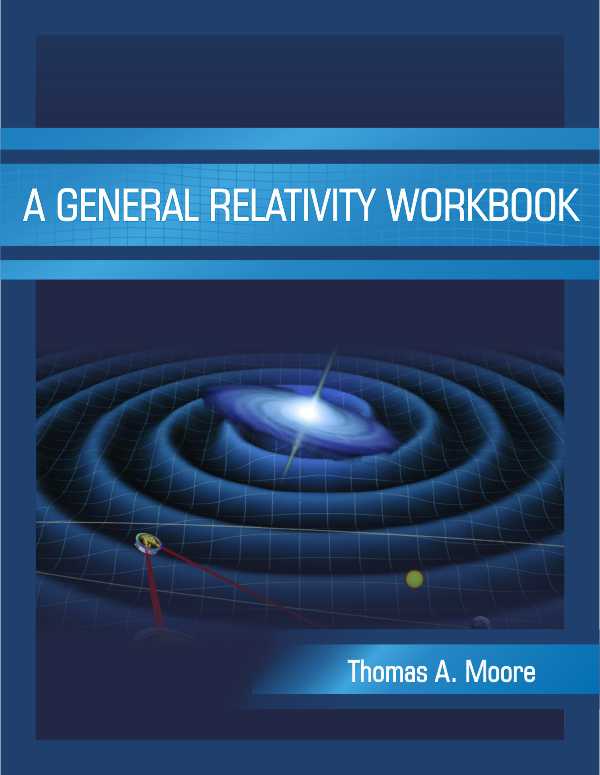
A General Relativity Workbook
General relativity, which lies at the heart of contemporary physics, has recently become the focus of a number of lively theoretical, experimental, and computational research programs. As a result, undergraduates have become increasingly excited to learn about the subject.
Summary
General relativity, which lies at the heart of contemporary physics, has recently become the focus of a number of lively theoretical, experimental, and computational research programs. As a result, undergraduates have become increasingly excited to learn about the subject.
A General Relativity Workbook is a textbook intended to support a one-semester upper division undergraduate course on general relativity. Through its unique workbook-based design, it enables students to develop a solid mastery of both the physics and the supporting tensor calculus by pushing (and guiding) them to work through the implications. Each chapter, which is designed to correspond to one class session, involves a short overview of the concepts without obscuring derivations or details, followed by a series of boxes that guide students through the process of working things out for themselves.
This active-learning approach enables students to develop a more secure mastery of the material than more traditional approaches. More than 350 homework problems support further learning. This book more strongly emphasizes the physics than many of its competitors, and while it provides students a full grounding in the supporting mathematics (unlike certain other competitors), it introduces the mathematics gradually and in a completely physical context.
Translated into French.
Resources
List of Adoptions
Link to Online Student Manual
Preface
Complete Frontmatter with Detailed Contents
Online Student Manual with Hints and Answers for Selected Problems
Accompanying Author Website
Errata
Table of Contents
1. Introduction
2. Review of Special Relativity
3. Four-Vectors
4. Index Notation
5. Arbitrary Coordinates
6. Tensor Equations
7. Maxwell’s Equations
8. Geodesics
9. The Schwarzschild Metric
10. Particle Orbits
11. Precession of the Perihelion
12. Photon Orbits
13. Deflection of Light
14. Event Horizon
15. Alternative Coordinates
16. Black Hole Thermodynamics
17. The Absolute Gradient
18. Geodesic Deviation
19. The Riemann Tensor
20. The Stress-Energy Tensor
21. The Einstein Equation
22. Interpreting the Equation
23. The Schwarzschild Solution
24. The Universe Observed
25. A Metric for the Cosmos
26. Evolution of the Universe
27. Cosmic Implications
28. The Early Universe
29. CMB Fluctuations and Inflation
30. Gauge Freedom
31. Detecting Gravitational Waves
32. Gravitational Wave Energy
33. Generating Gravitational Waves
34. Gravitational Wave Astronomy
35. Gravitomagnetism
36. The Kerr Metric
37. Particle Orbits in Kerr Spacetime
38. Ergoregion and Horizon
39. Negative-Energy Orbits
Index
Reviews
“Anyone interested in learning about this fascinating theory will find A General Relativity Workbook to be captivating. The book’s lively style and novel design make it as easy as possible for students and nonexperts to grasp the physical concepts behind the theory…Furthermore, the book contains a wealth of useful exercises and homework problems, including ones about such exciting and modern topics as cosmic rays, gravitational lensing, inflation, and gravitational radiation from binary pulsars. I strongly recommend A General Relativity Workbook to instructors teaching general relativity and to their students.”
-Physics Today (click here to read the complete review)
“Moore’s workbook makes General Relativity accessible to undergraduates who have seen little or none of the underlying mathematical framework. This is achieved not by watering down the contents, but rather by systematically guiding readers to work everything out themselves until they own the concepts and the mathematical techniques.”
-Sergio Picozzi, University of Maryland
“With its clean organization, its direct and clear prose, and especially its pedagogically effective workbook format, Moore’s A General Relativity Workbook may quickly become the new standard for upper division undergraduate courses in General Relativity.”
-John Mallinckrodt, Cal Poly Pomona
“Not since Misner, Thorne & Wheeler has there been such a useful reference.”
-Paul McKenna, Glasgow Caledonia University

